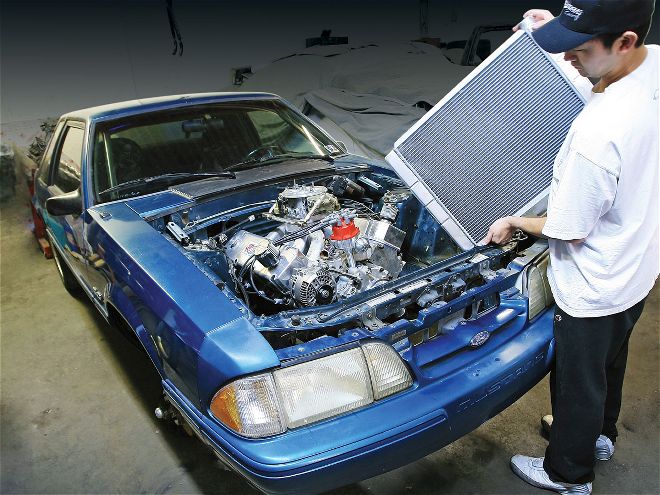
Walk up to the plate already three strikes in the hole, and you might as well not even show up. You've struck out before your at bat even begins. That's the predicament we faced with our '93 Mustang project car. It boasts a big 532ci motor, a heady 775 hp, and lives in a brutal Texas climate that rarely drops down below triple digits in the summer. With the unrelenting heat just around the corner, and race season quickly approaching, we had to come up with an effective and cost-efficient solution for our formidable cooling system demands. While we were expecting to shell out close to $1,000, after doing some research and scouring eBay, we got the job done for just $305.
The rock of Project Fox's new cooling system is a Summit universal aluminum radiator that lists for $160. It was matched up with an electric cooling fan pulled out of a late-model Lincoln Mark VIII, and a Summit 160-degree thermostat. Controlling the fan is a Derale thermostat switch, which automatically turns the fan on at 180 degrees, and shuts it off at 165 degrees. This simple arrangement eliminates the need to manually activate the fan with a toggle switch, and is far less expensive than a programmable aftermarket fan controller. If necessary, there's always the option of wiring in a manual override switch in concert with the automatic on/off setup. Finally, since the Mark VIII fan has a healthy appetite for juice, we hooked it up to a Dakota Digital 70-amp relay.
Although it will be spring by the time this story hits the newsstands, we're putting it together in the middle of January. Consequently, the cobbled-together cooling system we're touting has yet to be tested, but we're quite confident that it will hold up just fine in the unrelenting heat. That's because Summit's budget-priced radiators are proven performers, and the ace in the hole known as the Mark VIII fan. This little beast flows in the neighborhood of 5,000 cfm of air-which is a solid 1,000-2,000 cfm more than the best aftermarket fans around-and can be scored online or out of a salvage yard for $50.

In a hobby whose participants are predisposed to chuck anything that's stock in the dumpster, those figures may seem alarming. Think about it for a few seconds, however, and it all makes perfect sense. Compared to the typical musclecar, late-models feature very small radiator cores due to cramped engine bays, and the need to reduce weight. In fact, traditionalists would be shocked at the diminutive size of modern radiators, many of them supporting in excess of 700 hp in hopped-up GM LS- and Ford mod-motor applications. Throw in the fact that most late models have small grilles, non-functioning grilles, or no grilles at all, and it's obvious why their cooling fans have to pull so much air. Another huge bonus is that the OE's have to design their products to last for hundreds of thousands of miles. While you'll have to wait a few more months for a progress report on how well Project Fox's cooling system performs in stop-and-go traffic, in the meantime, here's how to assemble a budget cooling system à la carte. Thanks again to Bill Buck Race Cars in Austin, Texas for letting us take over their shop for the day to get Project Fox one step closer to completion.
Mark VIII Fan
Universal consensus is a rarity in a scene as opinionated as hot rodding, but not when it comes to budget cooling fans. Whether the online message boards you frequent cater to the Chevy, Ford, Mopar, Pro Touring, Pro Street, or drag racing creed, typing "Mark VIII fan" into the search box will yield similar results. Just about everyone agrees that, dollar for dollar, it can't be beat in terms or airflow, and will cool just about anything you throw at it. That said, "Mark VIII" fan is a somewhat ambiguous term used to describe a variety of fans Ford installed in many of its cars in the '90s. These fans come in both single- and dual-speed designs, and with different combinations of fan motor and fan blade arrangements. Nonetheless, whichever one you get, they all move serious air. In independent testing, the different variants of the Mark VIII can move anywhere from 4,000 to 5,000 cfm of air.
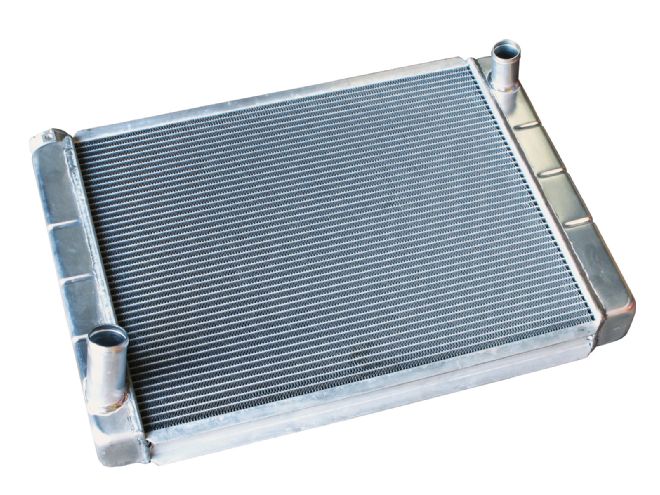 After taking the appropriate measurements in Project Fox's engine bay, we ordered a 27.5x19x2.25-inch radiator from Summit Racing. Its two-row design with high-capacity 1-inch tubing is said to outperform four-row copper/brass radiators. Other highlights include aluminum end tanks, a 1.5-inch inlet, and a 1.75-inch outlet. At $160, we're practically stealing it.
After taking the appropriate measurements in Project Fox's engine bay, we ordered a 27.5x19x2.25-inch radiator from Summit Racing. Its two-row design with high-capacity 1-inch tubing is said to outperform four-row copper/brass radiators. Other highlights include aluminum end tanks, a 1.5-inch inlet, and a 1.75-inch outlet. At $160, we're practically stealing it.
As the name implies, the true Mark VIII fan is an 18-inch unit that equipped '93-98 Lincoln Mark VIII coupes. The '93-96 models are two-speed units, while the '97-98 models are single-speed fans that relied on a factory variable-speed controller. The later fans are rumored to flow about 500 cfm more air, and are easily identified by their white pigtail plugs, however, insisting on a single-speed fan isn't necessary. The dual-speed fans move so much air in low-speed mode that many users report that their fans never even switch into the high-speed circuit. Ford installed similar 18-inch fans with equally astounding airflow into mid-'90s Thunderbirds and Mercury Cougars. Ford also installed 17-inch fans in Tauruses equipped with 3.8L V-6 engines that move some serious air as well. Another benefit of transplanting a factory fan into a hot rod application is that they include an integrated shroud. So if you need an affordable high-performance fan, you now know where to look. -Stephen Kim
Picking out the right radiator hoses for any engine swap application is a matter of trial and error. We picked up a set of hoses for a 429-powered '76 Ranchero from the local parts store to get us in the ballpark. Tried-and-true methods, like bending up a piece of coat hanger to use as a template at the parts store, work just as well.
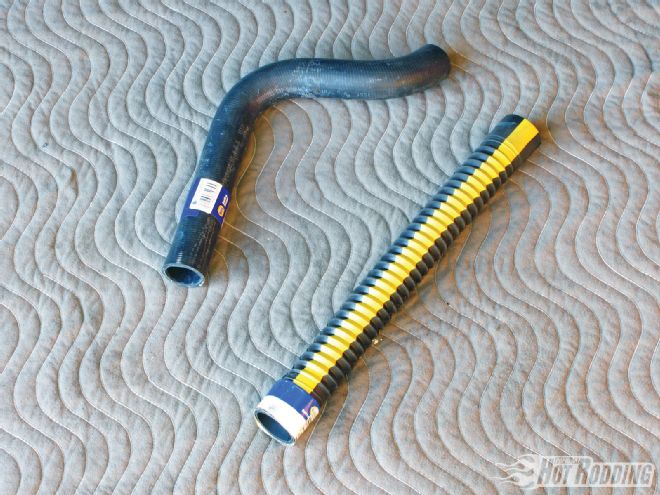
The $50 Mark VIII fan we scored off of eBay was pulled out of a '98 Lincoln. It arrived a bit dusty, but was in otherwise excellent condition. We gave it a quick cleaning and degreasing before dropping it into the car.
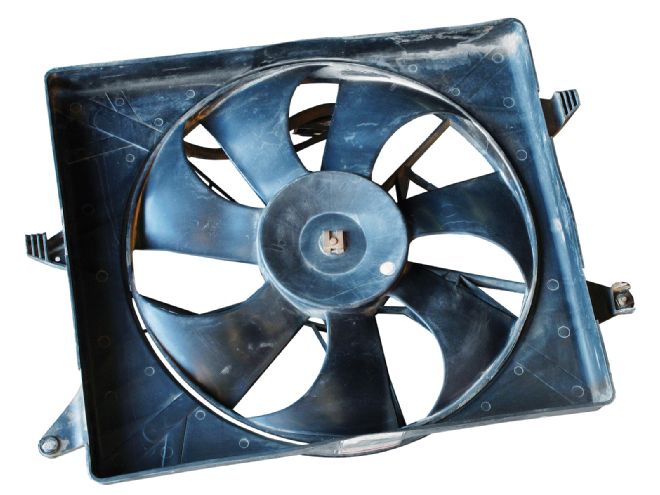
Mark VIII fans have three wires that power the motor. On two-speed versions of the fan, one wire activates low-speed operation, another wire activates high-speed operation, while the remaining wire serves as the ground. On one-speed fans such as ours, the outer wires work as the power and ground, while the center wire is a dummy that serves no purpose at all.
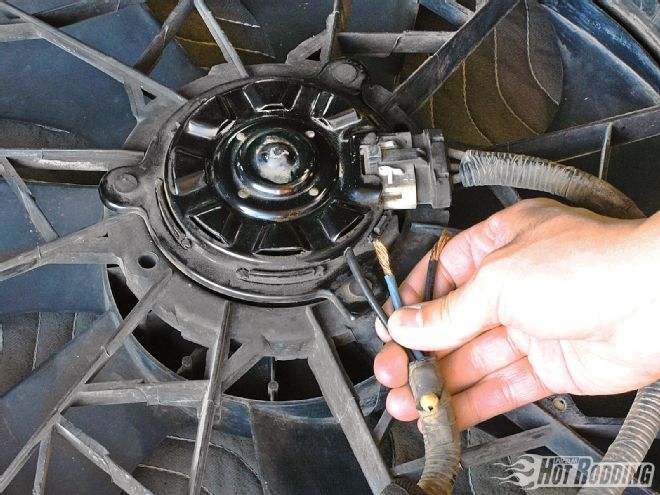
The aftermarket abounds with both screw-in and probe-style thermostat switches that turn fans on and off automatically at different thresholds. This Derale unit will turn our Mark VIII fan on at 180 degrees, and turn it off at 165 degrees. We matched it up with a 160-degree Summit thermostat. In a healthy cooling system, the cooling fan controls how hot an engine gets, and the thermostat regulates how cold the motor gets. Hence, it's important to select a thermostat that opens up below the cooling fan activation threshold. If the thermostat opens at a temperature above the activation threshold of the fan, then the fan will run continuously regardless of how well the radiator dissipates heat.
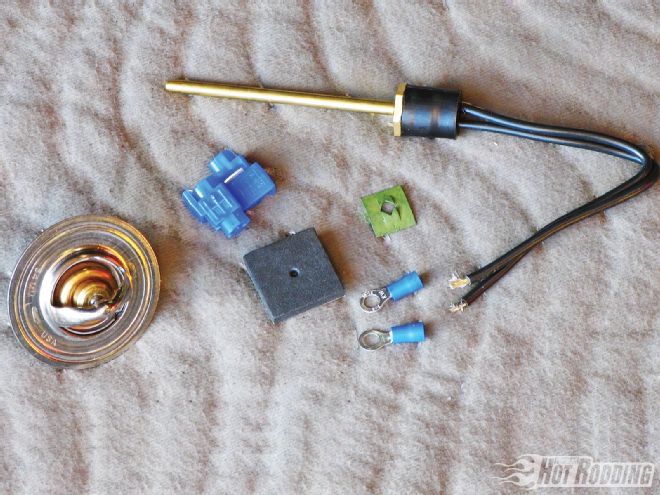
The only real drawback of the Mark VIII fan is that it draws a hungry 30 to 40 continuous amps, and can momentarily spike up to a 100-amp draw at startup. The easy fix is a high-capacity relay, such as this 70-amp unit from Dakota Digital. To put this into perspective, many aftermarket fan controllers come equipped with 25-35 amp relays. High-capacity relays such as the Dakota Digital unit may be hard to find at the local parts store, so we tracked one down on eBay.
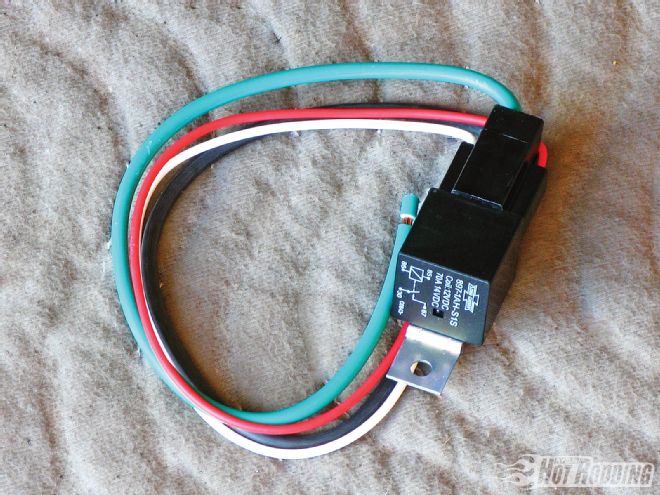
Power hungry fans can quickly drain a battery if the alternator isn't up to snuff, and that's definitely the case with the Fox Mustang's puny 75-amp unit. We replaced it with a Ford 3G alternator out of a SN95 Mustang rated at 130 amps. It features an internal regulator and cooling fan, and runs cooler than the stock unit. The 3G alternator comes in both small- and large-frame designs, and is a very popular upgrade in older Fords. We picked our rebuilt 3G alternator up on eBay for $40.
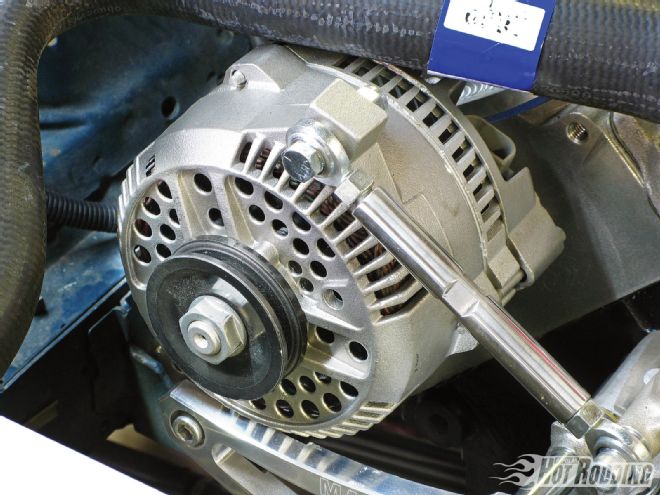
For extra insurance, we poured in a bottle of Purple Ice coolant additive from Royal Purple after dropping the radiator in place. This synthetic additive reduces engine temperature by lowering the surface tension of the radiator fluid for improved heat transfer. It's compatible with standard green coolant and GM Dex-Cool, and lubricates seals. In applications that run straight water, Purple Ice prevents rust formation too.
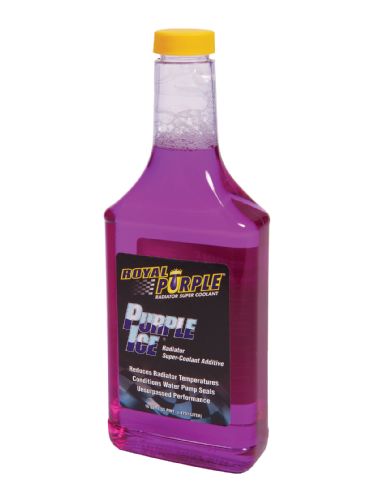
Derale recommends inserting the thermostat probe as close to the radiator inlet as possible. Positioning it too far from the inlet can cause the fan to turn on too late. The probe must be pushed in very gently to prevent damaging the fins.
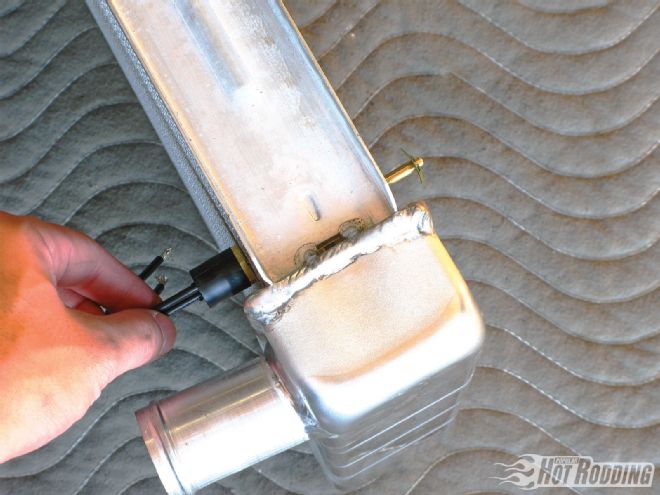
The probe is held in place on the opposite side of the radiator using a small foam pad and a retaining clip. The excess section of the probe can be trimmed off if desired.
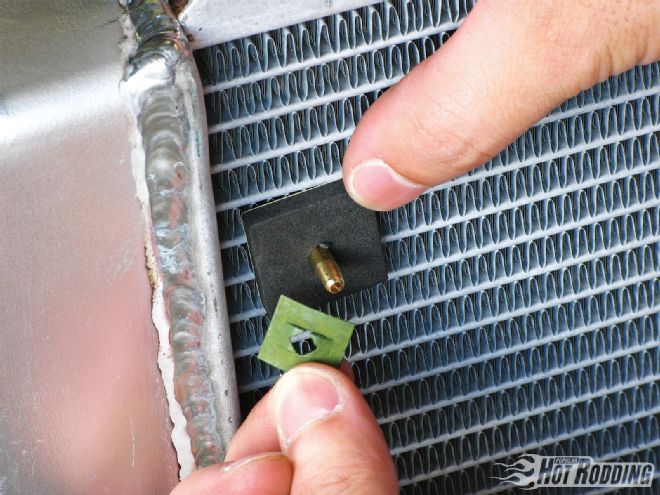
Before installing the Mark VIII fan, it needed a quick trimming. Like most factory designs, the Mark VIII fan uses mounting tabs to hold it in place. Since we'll be attaching it directly to the radiator, we cut them off with a jigsaw.
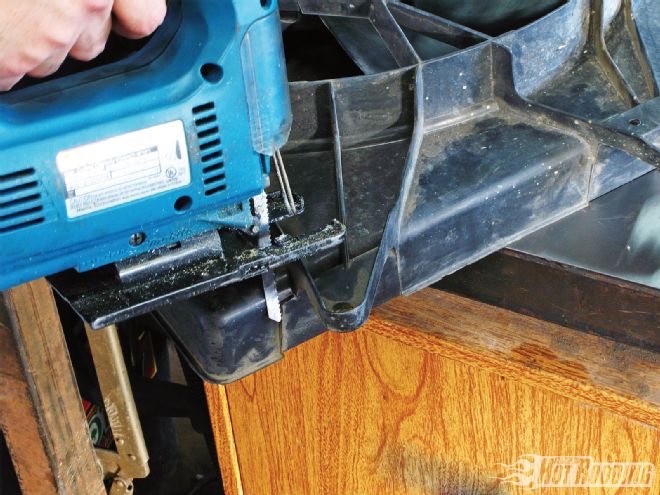
Dropping a big-block into a Fox chassis leaves very little space between the water pump and cooling fan. The shroud on the Mark VIII measures 5.5 inches deep. We trimmed it back using a jigsaw to 4.25 inches, which was the most material that could be removed while still enabling the fan blades to rotate freely.
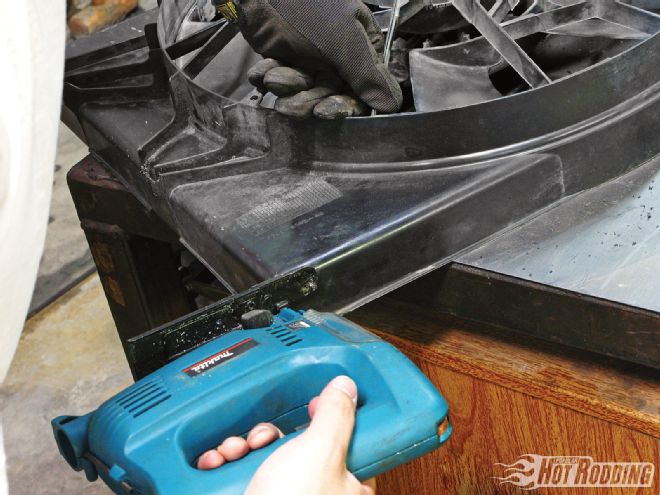
The final step in modifying the Mark VIII fan was drilling holes for the mounting tabs and thermostat switch wires. We drilled a 3/8-inch hole near the radiator inlet through which we routed the thermostat switch wires, and drilled 1/4-inch holes at each corner, which will be used to attach it behind the radiator.
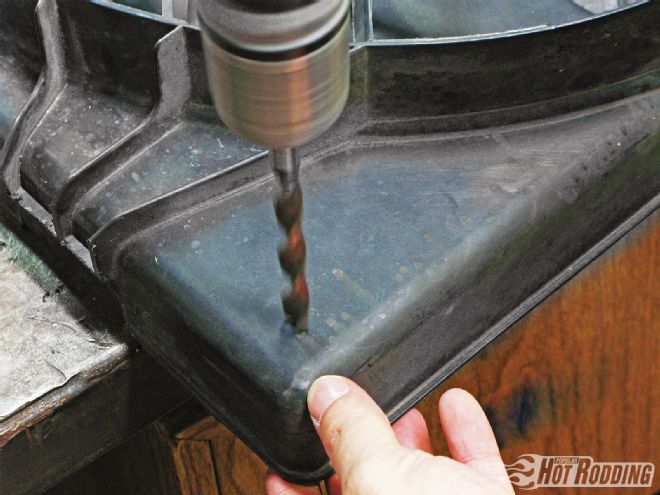
After trimming the fan, it measured 21.5x18.5, and fit between the radiator tanks perfectly. Ideally, the fan shroud should cover about 80 percent of the radiator core. In our application, it covers nearly 100 percent of the core.
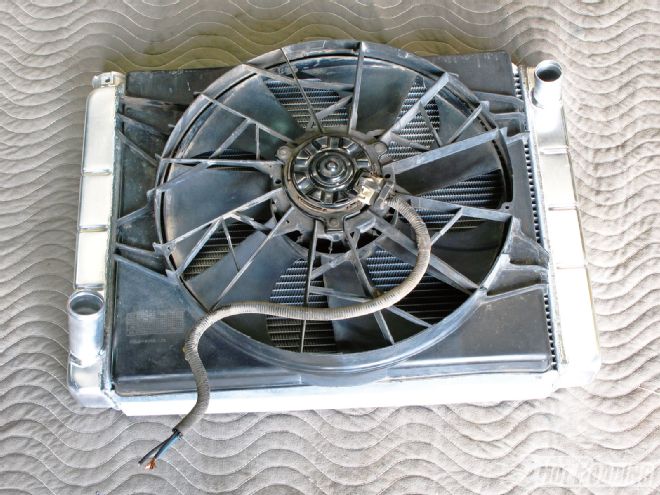
The Summit radiator fit perfectly into the factory core supports. To hold it in place, we fabbed up a pair of straps from thin strips of flat steel. They were bolted to the frame using some existing holes, and were lined with weatherstripping to prevent metal-to-metal contact.
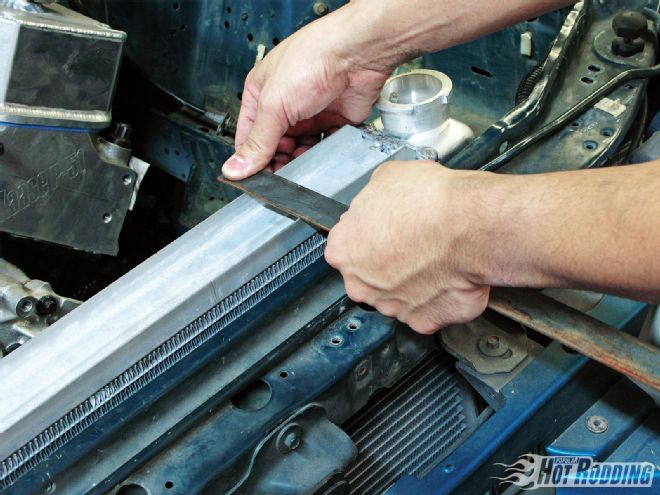
The Ranchero upper radiator hose cleared the alternator beautifully after shortening it by 4 inches. The lower radiator hose was about 5 inches too long, so we swapped it out for a universal 12-inch flexible hose from the parts store.
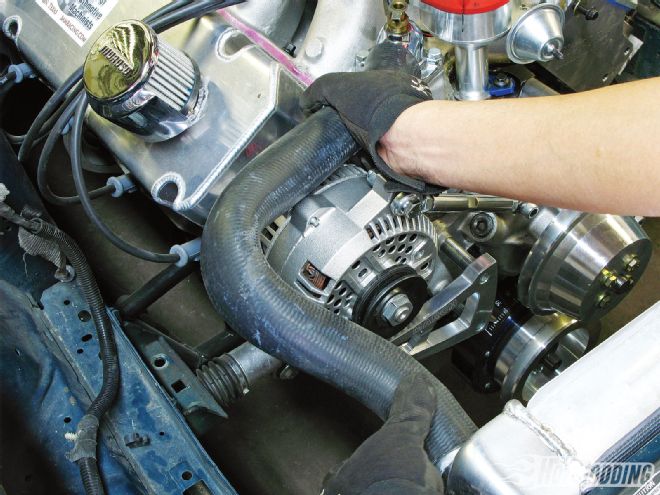
The fit was super tight, but the Mark VIII fan just barely cleared the water pump. We mounted it to the radiator by drilling holes into the aluminum strips on the top and bottom of the core.

Using an existing hole where the stock airbox once mounted, we attached the relay in front of the passenger side shock tower. We ran a 10-gauge wire (green) from the battery to the relay, and a 12-guage wire from the relay to the fan (black). Thinner 22-gauge wire was used for the switched ignition source (red) and relay ground (white).
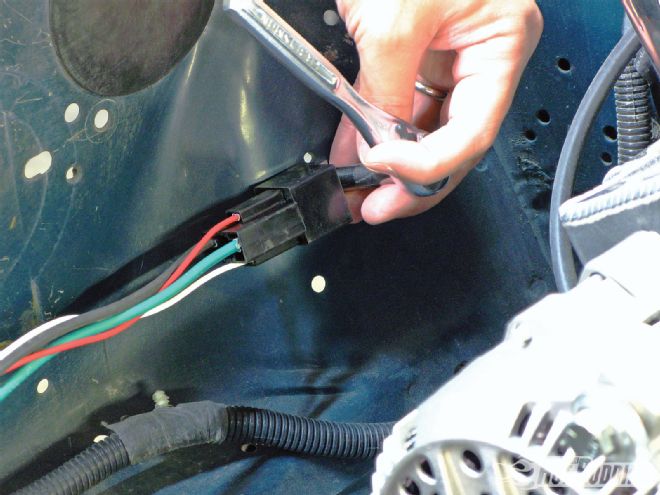
Even for those who despise electrical work, wiring up an automatic fan switch is cake. Looking at this diagram, hooking up an automatic thermostat is as easy as splicing it in between the relay's red wire, and a switched ignition source. A manual override switch can also be setup by splicing into the red wire in front of the thermostat switch.
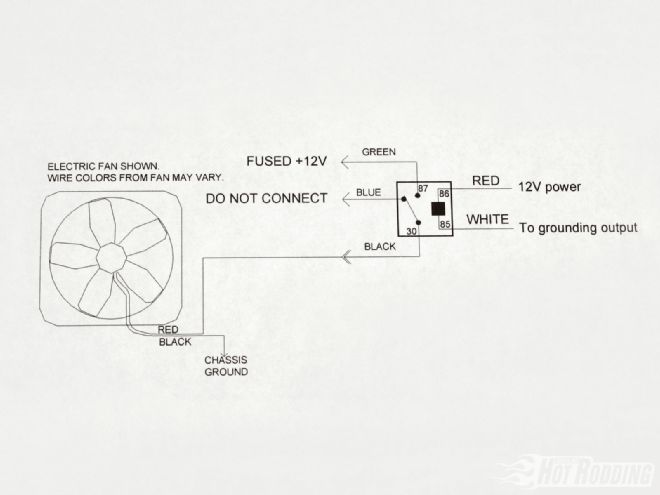
WHERE THE MONEY WENT Item: PN: Price: Summit radiator 380428 $160 eBay Mark VIII fan N/A $50 Derale fan switch 16738 $22 Dakota Digital relay RLY-3 $25 Summit thermostat 360160 $8 Hoses N/A $40 Total: $305
THE COST SO FAR Description: PHR Issue: Price: '93 notchback Mustang November 2009 $3,000 Sold old wheels, tires, engine, trans N/A -$1,000 532 big-block Ford June 2009 $9,644 Phoenix TH400 trans September 2009 $1,645 Strange 8.8 rearend October 2009 $1,759 Comp Engineering rear suspension November 2009 $1,708 AJE front suspension December 2009 $1,679 Bill Buck custom 10-point cage January 2010 $2,000 Engine and trans install March 2010 $690 Russell fuel system April 2010 $804 Cooling system May 2010 $305 Total: $22,234